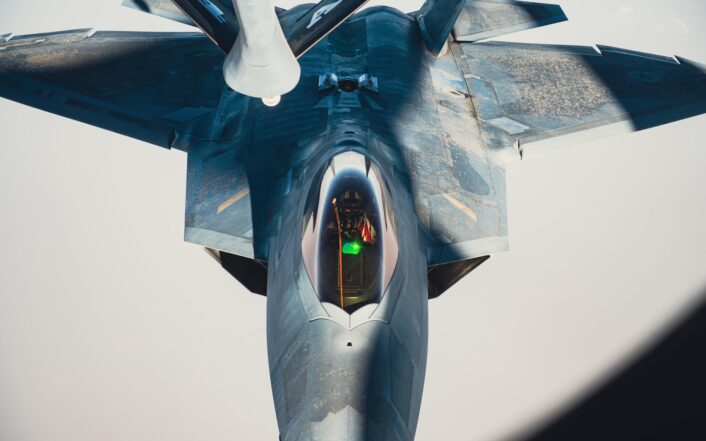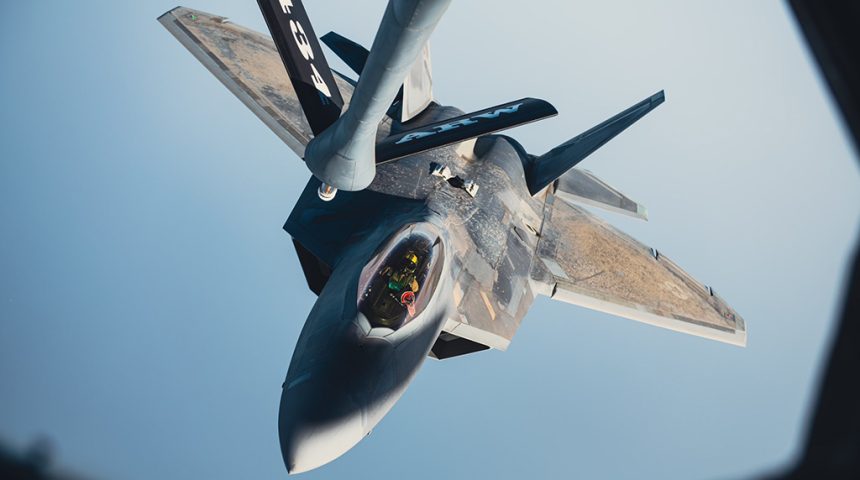Pretty interesting photos show at least one Raptor with dust/sand deposits on most of its upper surfaces.
A dozen U.S. Air Force F-22 Raptors belonging to 1st Fighter Wing at Joint Base Langley-Eustis, Virginia, deployed to the UAE, last month. The aircraft made a stopover in Spain, at Moron Air Base and eventually arrived at their final destination, Al Dhafra, on Feb. 12, 2022.
The deployment of a squadron of F-22s to the Middle East was announced a few days earlier when General Kenneth F. McKenzie, commander of the US Central Command (CENTCOM), announced that the U.S. would deploy the 5th generation aircraft to UAE to help defend the country against Houthi terrorist strikes.
Some photographs of the Raptors at work in the CENTCOM AOR (Area Of Responsibility) have been released in the last few weeks every now and then, but the ones that have recently been posted to the Pentagon’s Defense Visual Information Distribution Service, or DVIDS, website reveal the effect of just one month in the “sandpit” on the 5th generation aircraft.
The photos, taken by Staff Sgt. Stefan Alvarez aboard a KC-135 Stratotanker on March 9, 2022, show a U.S. Air Force F-22 Raptor pilot assigned to the 380th Air Expeditionary Wing during air-to-air refueling as part of OAS II (Operation Agile Spartan II) somewhere over Southwest Asia.
A very dusty Raptor.
US Air Force F-22 assigned to 380th Air Expeditionary Wing approaches a KC-135 over Southwest Asia on Mar. 9. F-22s participated in Operation Agile Spartan II and conducted Agile Combat Employment concepts throughout Central Command area of responsibility. pic.twitter.com/UDO2egXk8r
— Ryan Chan 陳家翹 (@ryankakiuchan) March 14, 2022
As the images show, the silver skin of the U.S. Air Force’s premier fighter appears to be widely covered by dust/sand deposits on most of the aircraft upper surfaces. Although some photographs have shown the extent of weathering on the precious Radar-absorbent skin of the F-22 in the past, we have never seen so much dust accumulated on the jet’s coating as to be clearly visible to the naked eye.
The photographs don’t allow us to determine whether the sand/dust may have eroded the F-22’s coating, but we are pretty sure those particles are not too good for the delicate skin of the stealth aircraft.

“The aircraft’s outer mold-line is a mosaic of radar-absorbent coatings and radar transparent and radar defeating composite structures that combine to allow the Raptor to remain aerodynamically efficient while also largely invisible to fire control radars. All this takes a lot of work to maintain and many of these applications start degrading shortly after they are applied, with friction from high-speed flight, crushing G forces, and the elements accelerating that process. As such, one of the costliest aspects of operating F-22s—and flying this aircraft is extremely expensive with an average flight hour cost of about $60k—is keeping its stealthy skin up to par,” wrote Tyler Rogoway in an article about the extreme signs of corrosion shown by a Raptor published by The War Zone in 2019.
“For aircraft that aren’t headed into combat or high-end training scenarios, maintaining the jet’s stealthy skin isn’t as high of a priority. There are different standards of readiness for F-22 skins to be kept at depending on the situation, with its effectiveness slipping a certain percentage before needing time-consuming reapplication.”
In this case, the aircraft were actually operating from forward operating location where they deployed on a short-notice to carry out deterrence missions, however, considered the posture at the time the photos were taken, it seems quite likely that LO (Low Observability) was not a requirement for the jet, meaning that it could still be safely flown without going through the cleaning or (if needed) repairing process.
According to the U.S. Air Force, the F-22 Raptors deployed to Al Dhafra, participated in Operation Agile Spartan II and conducted Agile Combat Employment concepts throughout the U.S. Central Command area of responsibility, which showcased U.S. Air Force’s flexibility to operate from any location in a contested environment.
BTW, dealing with F-22 coatings, we have already reported about a kinda mysterious Nellis Air Force Base’s F-22 first caught on camera on Nov. 19, 2021, featuring a “mirror-like” coating, never seen before on a Raptor. As we have explained, the reflective metallic coating appears to cover most of the outer “skin” of the aircraft leaving very evident panel lines, including some saw tooth ones above and on the sides of the fuselage (typical of stealth aircraft), as well as some unusual curvilinear ones (on the wings in the flaps area). The reason for the so-called “Chrome” or “Mirror-like” coating, is probably related to some testing activity, on IRST (Infra Red Search & Track) technologies, targeting systems or laser weapons and countermeasures.









